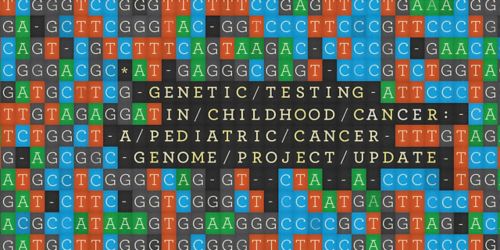St. Jude Family of Websites
Explore our cutting edge research, world-class patient care, career opportunities and more.
St. Jude Children's Research Hospital Home

- Fundraising
St. Jude Family of Websites
Explore our cutting edge research, world-class patient care, career opportunities and more.
St. Jude Children's Research Hospital Home

- Fundraising
Genetic testing in childhood cancer: a Pediatric Cancer Genome Project update

Landmark project is the first effort specifically designed to understand the genetic changes that give rise to childhood cancer.
Eight years ago, as then-scientific director of St. Jude, I proposed an idea to the leaders of St. Jude Children’s Research Hospital: to map the genomes of some of the world’s most aggressive and least-understood childhood cancers. We would compare the complete genomes from both cancerous and normal cells to pinpoint the genetic factors underlying these diseases.

James R. Downing, MD
Looking back, it was an audacious proposal. At that time, not even one pediatric cancer genome had been sequenced. The public and private large-scale sequencing projects then underway largely ignored pediatric cancer because, compared to adults, relatively few children and teens develop cancer. But that void underscored the need.
Cancer remains the leading cause of the death from disease in children. And, while overall survival rates were at 80%, successes to that point had been incremental. Progress seemed to have plateaued.
We believed the next breakthrough would come from an unprecedented survey of the biological landscape of pediatric tumors. Understanding at a genomic level why cancers begin or how tumors resist treatment would give us insights for designing more effective and targeted ways to treat the disease.
Thanks to the St. Jude Biorepository, St. Jude already had access to an extensive collection of tissue samples donated by current and former patients, as well as by participants in St. Jude clinical trials worldwide. However, at that time we lacked the sequencing capabilities for a project of this magnitude. We found a great partner for this project: Washington University School of Medicine in St. Louis, a leader in high-speed, large-scale genomic sequencing. Timothy Ley, MD, a Washington University researcher with expertise in cancer genomics and leukemia, as well as Richard Wilson, PhD, and Elaine Mardis, PhD, then co-directors of the university’s McDonnell Genome Institute, played pivotal roles in moving the effort from idea to reality.
A landmark project
In 2010, with an initial investment of $65 million over three years, St. Jude and Washington University announced the Pediatric Cancer Genome Project (PCGP). This was the first effort dedicated solely to understanding the genetic changes that give rise to childhood cancer.
The first phase of the PCGP unearthed a treasure trove of information, providing groundbreaking discoveries in brain tumors, leukemia, a cancer of the peripheral nervous system, an eye tumor and the degenerative disorder commonly known as Lou Gehrig’s disease. The project also generated new computational tools that benefit the broader field of genomic medicine.
To speed discoveries, in 2012 our researchers began to release the data uncovered by the PCGP as soon as it was validated. The decision resulted in the largest-ever release of comprehensive human cancer genome data to the global scientific community—and at no cost.
Sharing discoveries with the world
Discoveries from the PCGP have been published widely in peer-reviewed medical and scientific journals. The project has also garnered widespread media attention. In 2012, TIME magazine recognized the initiative as one of the year’s top 100 scientific discoveries and top-10 medical breakthroughs.
The project has produced a massive amount of data— 100 trillion-plus pieces— representing the complete normal and cancer genomes of more than 800 children and adolescents with 23 different childhood cancers.
To mine the data, we organized a team of 21st century code breakers who developed the tools to help researchers find blips in the genetic code that deserve attention. Four software applications were created—CREST, CICERO, CONSERTING and ProteinPaint—and made available freely to researchers everywhere. These algorithms have helped identify key driver mutations that less sophisticated methods have missed.
Construction of a pipeline
Based on the success of the first phase of the PCGP, St. Jude committed an additional $30 million to extend the project. Phase II was built around two distinct efforts: A Discovery Project and a Clinical Genomics Project.
Through the Discovery Project, researchers analyzed cancer samples from 300 children, studying in detail a small number of leukemias, brain tumors and solid tumors. Findings from the initiative are still being published.
The Clinical Genomics Project was designed to make next-generation sequencing an option for every eligible St. Jude cancer patient. St. Jude was the first institution to tackle such a project, through an initial clinical trial called Genomes for Kids. Other institutions using genomic analysis perform only whole-exome sequencing, which looks at a slice of the human genome—about 1 to 2%. St. Jude has also been doing whole-genome sequencing and RNA sequencing.
Now we are creating a precision medicine pipeline, in which mutations are discovered in a child, a team of scientists identifies drugs that target those particular alterations, and the treatment is provided to the child.
Help for individual families
The first results of the program were reported in a landmark study published in the New England Journal of Medicine in 2015. Researchers found that 8.5%—nearly one in 10—of patients studied were born with genetic changes or mutations that increased their cancer risk. These changes, called germline mutations, are found in the DNA of every cell, not just tumor cells. Such mutations were known to exist, but their frequency was a mystery.
These mutations can be used to help guide treatment and advance precision medicine. In some cases, entire families may benefit from genetic testing and counseling. St. Jude recruited Kim Nichols, MD, to launch a clinic to help children who may have inherited genetic mutations that increase their cancer risk, answering important questions for many families.
The Hereditary Cancer Predisposition Clinic evaluates children who have hereditary forms of cancer as well as kids who do not have cancer but have genetic conditions or family histories that put them at increased risk for developing it. From studying the family tree and the child’s medical information, licensed certified genetic counselors determine if any family members, including future children, might have a higher-than-normal likelihood of developing cancer.
The counselors educate the families. If genetic testing is needed, the staff and families discuss the risks, benefits and limitations of those tests. When a genetic diagnosis is made, the clinic staff helps families obtain appropriate medical care as well as mental, emotional, social and spiritual support.
Encouraged from the early findings from Genomes for Kids and progress of the Hereditary Cancer Predisposition Clinic, St. Jude has started incorporating next-generation sequencing into frontline care for all eligible patients.
The progress continues
For decades to come, scientists will continue to glean insights into childhood cancer through data generated by the PCGP. The latest news from the project includes such announcements as these:
- As an outgrowth of the PCGP, scientists created the world’s largest collection of pediatric solid tumor samples, drug-sensitivity data and related information and made the resource available at no charge to the global scientific community.
- We conducted the first comprehensive analysis of neoepitopes—potential targets of immunotherapies—in pediatric cancers.
- A PCGP team, led by Michael Dyer, PhD, and Jinghui Zhang, PhD, determined how retinal cells transition from immature cells to mature retinal neurons—offering a peek into the cellular origins of the eye cancer retinoblastoma.
- Scientists, led by Charles Mullighan, MBBS, MD, and Zhang, found genetic changes underpinning a subtype of B-precursor acute lymphoblastic leukemia. The results have led to new diagnostic approaches.
- We completed a detailed map of the genomic changes found in core-binding factor acute myeloid leukemia. The results also highlight genes that may be crucial for patients at risk of relapse. Zhang, Jeffery Klco, MD, PhD, and Lars Bullinger, MD, PhD, of the University of Ulm in Germany, help lead the work.
- We found key mutations that drive the growth of rare brain cancers in children. Therapies targeting some of these mutations are already being tested in clinical trials. The discovery may also help improve diagnosis of these tumors. David Ellison, MD, PhD, was the study’s corresponding author and principal investigator.
These achievements are just the tip of the iceberg. This ambitious effort to plumb the origins of childhood cancer is yielding more discoveries every day. Each finding brings us one step closer to finding cures for these cancers and saving young lives around the world. To read about other findings from the PCGP, as well as find data to use in your own research, please visit stjude.org/pcgp.






